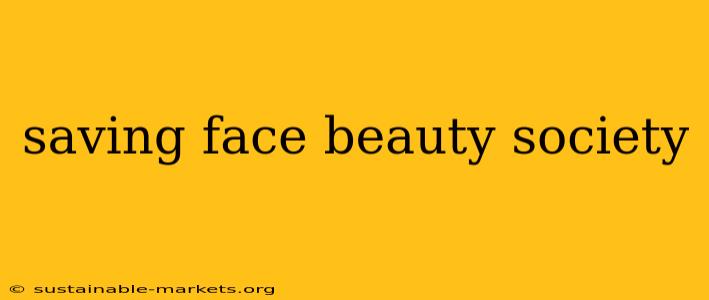The pursuit of beauty is a timeless human endeavor, woven into the fabric of societies across cultures and eras. But what happens when the pursuit of beauty becomes a relentless pressure, a societal expectation that impacts self-worth and mental well-being? This is the complex reality behind the concept of "saving face," particularly as it relates to beauty standards. This exploration delves into how societal pressures surrounding beauty impact individuals, the psychological toll of striving for unattainable ideals, and the growing movement towards a more inclusive and accepting definition of beauty.
The Societal Pressure Cooker: Beauty Standards and Their Impact
For centuries, societies have defined beauty according to specific, often unrealistic, standards. These standards, propagated through media, advertising, and social interactions, create a powerful narrative that equates physical appearance with worth. The pressure to conform to these ideals is immense, particularly for women, but increasingly for men as well. This pressure isn't merely about aesthetics; it's deeply intertwined with self-esteem, social acceptance, and even economic opportunity.
Consequences of Failing to Meet Unrealistic Standards: Falling short of these idealized images can lead to a range of negative consequences, including:
- Low self-esteem and body image issues: Constant comparison to unrealistic beauty standards can erode self-confidence and foster feelings of inadequacy.
- Mental health challenges: Anxiety, depression, and eating disorders are frequently linked to the pressure to conform to societal beauty norms.
- Social isolation: Individuals who feel they don't meet beauty standards may withdraw from social situations, fearing judgment or rejection.
- Financial burden: The pursuit of beauty often involves significant financial investment in cosmetics, procedures, and clothing, placing unnecessary strain on individuals' finances.
The High Cost of "Saving Face": Psychological and Emotional Toll
The phrase "saving face" often implies maintaining social standing and avoiding shame. In the context of beauty, it means adhering to societal expectations to avoid negative judgment. This constant striving to conform can be incredibly draining, leading to:
- Chronic stress: The constant pressure to look a certain way contributes to ongoing stress and anxiety.
- Perfectionism: The pursuit of an unattainable ideal often fuels perfectionistic tendencies, leading to dissatisfaction and self-criticism.
- Social comparison: Endless scrolling through social media feeds filled with filtered images and idealized portrayals only exacerbates the problem.
- Burnout: The relentless effort to meet unrealistic beauty expectations can lead to emotional and psychological exhaustion.
Redefining Beauty: A Move Towards Inclusivity and Acceptance
Fortunately, a growing movement challenges these narrow definitions of beauty. The focus is shifting towards:
- Body positivity: This movement emphasizes self-acceptance and celebrates diversity in body shapes, sizes, and appearances.
- Authenticity: There's a growing appreciation for natural beauty and the rejection of unrealistic filters and airbrushing.
- Inclusivity: Brands and media outlets are increasingly showcasing diverse representations of beauty, reflecting the spectrum of human appearance.
- Mental health awareness: There's a greater understanding of the link between beauty standards and mental health, leading to increased support and resources.
Conclusion: Embracing a More Realistic and Healthy Approach
Saving face in the context of beauty shouldn't come at the cost of mental well-being. It's crucial to challenge unrealistic standards, foster self-acceptance, and prioritize mental health. By promoting inclusivity and realistic representations of beauty, we can create a more compassionate and supportive environment where individuals feel valued for who they are, not just how they look. The true measure of beauty lies not in conforming to societal pressures, but in embracing individuality and self-love.

